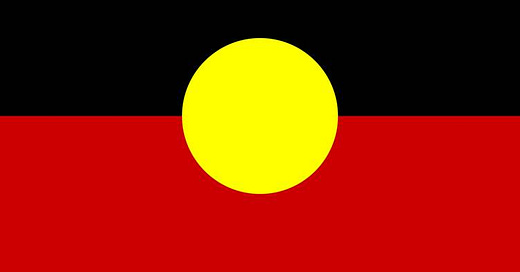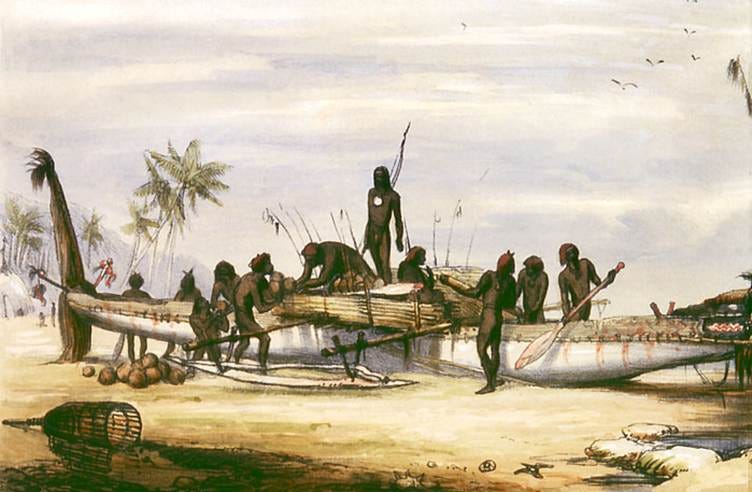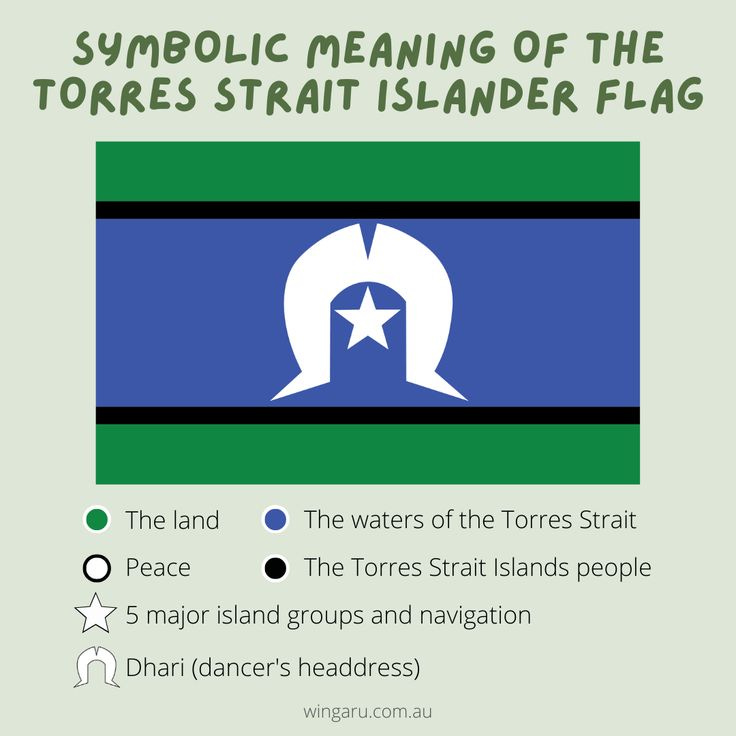Australian Aboriginal flag using the official on-screen display colours. By Original: Harold Thomas; Vectorization: Trisreed - The official on-screen display colour shades (RGB 204–0–0 and 255–255–0) were sourced from Style manual for authors, editors and printers, Public Domain, https://commons.wikimedia.org/w/index.php?curid=114651604
This is Part 2 of ‘Who Really Discovered Australia’, focussing on Aboriginal and Torres Strait Islander societies on the elusive sixth continent Sahul. Upgrade to a free or paid subscription for full access to posts, the archive of past reports and my ‘Newbies Guide to Substack’, with lots of helpful information.
CONTENTS:
Who are they?
Adapting to diverse environments
Trade and tools
Managing the land
Torres Strait Islanders
Sailing to Australia
Trading with the region
Evidence of Aboriginal society
Rich ethnic mixture
Who are they?
WHAT is an indigenous Australian? There are two very different groups: Aborigines and Torres Strait Islanders.
An accepted definition of an indigenous Australian proposed by the Commonwealth Department of Aboriginal Affairs in the 1980s and still used by some Australian Government departments today is; a person of Aboriginal or Torres Strait Islander descent who identifies as Aboriginal or Torres Strait Islander and is accepted as such by the community in which he or she lives. 1
However, many Aboriginal Australians prefer to be called by a tribal name such as Koori, Murri or Nunga, which is relevant to the greater region they are connected to.
Aboriginal identities can also directly link to their language groups and traditional country (a specific geographic location). For example, Gunditjamara people are the traditional custodians of western Victoria, the Gadigal people of the Eora nation are from Sydney, and the Yawuru people are the traditional custodians of Broome in Western Australia.
Another way Aboriginal and Torres Strait Islander people might describe themselves, which again relates to their country (including the waters), is ‘saltwater people’ for those who live on the coast, or ‘freshwater’, ‘rainforest’, ‘desert’ or ‘spinifex’ for people who live in that ecological environment.
Torres Strait Islander people prefer to use the name of their home Island to identify themselves to outsiders, for example a Saibai man or woman is from Saibai, or a Meriam person is from Mer. Many Torres Strait Islanders born and raised in mainland Australia still identify according to their Island homes.
Studies of Aboriginal genetic makeup are ongoing, but evidence suggests that they have genetic inheritance from ancient Asian, but not more modern peoples. They share some similarities with Papuans.
Adapting to diverse environments
Over tens of thousands of years, Aboriginal and Torres Strait Islanders developed technologies to better exploit their very diverse environments, long before the arrival of Europeans, who often did not understand how much the indigenous people had changed their environments to suit their ways of living.
Fibre and nets for use in watercraft and fishing were developed before 40,000 years ago. More complex tools, such as edge-ground axes hafted to wooden handles, appeared by 35,000.
Trade and tools
Elaborate trade networks also developed. For example, ochre was transported 250 kilometres from the Barrier Range to Lake Mungo 40,000 years ago. Shells (for decorative beads) were transported at least 500 kilometres by 30,000 years ago. More extensive trade networks developed in later times.
The warming climate was associated with new technologies. Small back-bladed stone tools appeared 15–19,000 years ago. Wooden javelins and boomerangs have been found dating back 10,000 years.
Stone points for spears have been found dating from 5000–7000 years ago. Spear throwers were probably developed more recently than 6,500 years ago.
Stone tools in Australia, as in other parts of the world, changed and developed through time. Some early types, such as wasted blades, core tools, large flake scrapers and split pebble choppers continue to be made today.
About 6000 years ago, new and specialised tools such as points, backed blades and thumbnail scrapers became common. Significant variation between the tool kits of different regions also appeared. Prototypes for this technology appeared earlier in Asia, suggesting this innovation was introduced into Australia.
The ground stone technique produces tools with a more durable and even edge, although not as sharp as a chipped tool. The oldest ground stone tools appear in Australia about 10,000 years before they appear in Europe, suggesting that early Australians were more technologically advanced in some of their tool manufacturing techniques than was traditionally thought. 2
The introduction of the dingo, possibly as early as 3500 BCE, showed that contact with South East Asian peoples continued, as the closest genetic connection to the dingo seems to be the wild dogs of Thailand, where they have been dated back at least 5000 years.
Aboriginal people lived over large sections of the continent, but maintained extensive networks within the continent and certain northern groups maintained relationships with Torres Strait Islanders and the Makassar people of modern-day Indonesia.
Managing the land
They were engaged in fire-stick land management, fish-farming, herding and hunting kangaroos and other wildlife.
They also practised agriculture, planting perennial seed crops across vast areas, which they visited regularly to harvest.
Bruce Childs in Dark Emu estimated the perennial native grains belt developed by indigenous Australians stretched across about two-thirds of the continent, which was wetter in the inland than now, making it larger than the current wheat belt.
Aboriginal people developed complex trade networks, inter-cultural relationships, law and religions, which make up some of the oldest, and possibly the oldest continuous cultures in the world.
Evidence of Aboriginal society
Rock art has mineral pigments such as ochre to provide some of the oldest evidence for human arrival in Australia. Used pigments have been found in the earliest occupation levels of many sites, with some pieces dated at about 50,000 years old.
This suggests that art was practised from the beginning of the first settlement. Natural pigments were probably used for a range of purposes including burials, cave painting, decoration of objects and body art. Such usage still occurs today.
Archaeological evidence for living sites of ancient Aboriginal peoples includes fishing traps and weirs, stone-base huts, possible fireplaces and remains of meals and cooking activities.
Shell middens are the most obvious remains of meals and provide insight into ancient Aboriginal diets and past environments and can also be radiocarbon dated to establish the age of a site.
Ancient DNA is easily contaminated and rarely survives for 30,000 years in conditions like those found in Australia.
Mungo Man found at Lake Mungo in western NSW has been dated at about 40,000 years, making him the oldest human remains found in Australia, while Mungo Woman found nearby has been dated at 30,000 years.
The Coobool Creek collection consists of the remains of 126 individuals excavated from a sand ridge at Coobool Crossing, New South Wales, in 1950. After their excavation, they became part of the University of Melbourne collection until they were returned to the Aboriginal community for reburial in 1985.
The remains date from 9000 to 13,000 years old and are significant because of their large size when compared with Aboriginal people who appeared within the last 6000 years.
They are physically similar to Kow Swamp people with whom they shared the cultural practice of artificial cranial deformation.
Kow Swamp ancient burial site in northern Victoria was excavated between 1968 and 1972. The human skeletons discovered were accurately dated between 9500 to 14,000 years ago and demonstrated substantial differences between ancient and more recent Aboriginal people.
The remains of over forty individuals have been found at Kow Swamp and include men, women and children. This burial site is one of the largest from this time period anywhere in the world.
Many of the skeletons have a greater skeletal mass, more robust jaw structures and larger areas of muscle attachment than in contemporary Aboriginal men. The female skeletons from this region also show similar differences when compared with modern Aboriginal women.
Evidence of human activity at Keilor dates back nearly 40,000 years. Stone flakes and charcoal deposits have been found in the lowest archaeological levels.
One of the key remains from this site was that of a 12,000 year old skull discovered in 1940. It is one of the earlier prehistoric Aboriginal remains found in Australia.
Talgai: A cranium was discovered in 1884 on the Darling Downs, Queensland. It was the first Pleistocene human skull to be found in Australia. It is dated to between 9000 and 11,000 years old.
At the time of first European contact, estimates of the Aboriginal population range from 300,000 to one million.
They were complex hunter-gatherers with diverse economies and societies. There were about 600 tribes or nations and 250 languages with various dialects.
https://aiatsis.gov.au/explore/indigenous-australians-aboriginal-and-torres-strait-islander-people
https://australian.museum/learn/science/human-evolution/the-spread-of-people-to-australia/
Torres Strait Islanders
Trading canoe at Erub (Darnley Island), c. 1849. By Harden Sidney Melville (1824-1894) - https://www.nla.gov.au/research-guides/torres-strait-islands-collection/eastern-islands, Public Domain, https://commons.wikimedia.org/w/index.php?curid=68559502
Torres Strait Islander people are of predominantly Melanesian descent, distinct from Aboriginal Australians on the mainland and some other Australian islands and share some genetic and cultural traits with the people of New Guinea.
Sailing to Australia
It appears that, having developed their sailing outrigger canoes, the ancestors of the Polynesians migrated from East Asia, including Taiwan, moved through the Melanesian area quickly on their way, and kept going to eastern areas, where they settled.
Around 4,000 years ago the first phase of occupation of the Torres Strait Islands began and by 2,500 years ago more of the islands were occupied and a distinctive Torres Strait Island maritime culture emerged.
Austronesians used distinctive sailing technologies, namely the catamaran, the outrigger ship, tanja sail and the crab claw sail . This allowed them to colonize a large part of the Indo-Pacific region during an expansion starting at around 3000 to 1500 BC, and ending with the colonization of Easter Island and New Zealand in the 10th to 13th centuries AD.
A map of the Torres Strait Islands. https://commons.wikimedia.org/wiki/File:TorresStraitIslandsMap.png
Trading with the region
Agriculture also developed on some islands and by 700 years ago villages appeared. 1.
Thursday Island is the best-known of the Torres Strait Islands, an archipelago of 274 small islands, only 17 inhabited, spread over 48,000 sq.km. separating Cape York Peninsula on mainland Australia from New Guinea.
Their maritime-based trade and interactions with the Papuans to the north and Australian Aboriginal communities have maintained a steady diffusion among the three societal groups, dating back thousands of years.
Torres Strait Islanders are a maritime culture, mainly Melanesian, and have their own history of travelling around the region.
Map showing the migration and expansion of the Austronesians which began at about 3000 BC from Taiwan. By Pavljenko - Own work using:Map first shown in Bellwood et al. (2011) and taken from Benton et al. (2012), CC BY-SA 4.0, https://commons.wikimedia.org/w/index.php?curid=116424449
Lieutenant James Cook was at Possession Island in Torres Strait when he first claimed British sovereignty over eastern Australia in 1770, but British administrative control of the Torres Strait Islands did not begin until 1862. 2.
Diving for pearl shells began in the 1860s and by the 1890s the islands were supplying half the world’s pearl shells.
Rich ethnic mixture
The history of regional contacts is revealed by the ethnic mix of the 4514 Torres Strait Islanders at the 2021 Census, being 22% Chinese, 17% Australians, 16% Malays, 12.5% English and 4% Indonesian.
They speak local languages Kalau Lagau Ya, Meriam Mir and Torres Strait Creole as well as English, Malay and Chinese dialects.
Most of the islands have been a part of Queensland since 1872, with tribal chiefs as magistrates, but currently they are administered by the Torres Strait Regional Authority.
A modern example of unofficial contacts is that people from the southern coast of Papua New Guinea frequently cross Torres Strait to Thursday Island off Cape York to shop or for medical treatment.
1. https://tsirc.qld.gov.au/about-us/our-region/
2. https://en.wikipedia.org/wiki/Torres_Strait_Islands
NEXT: Asian links to this continent before the arrival of Europeans. How did they miss Australia?









Great to see people apparently enjoying this post and the series 'Who Really Discovered Australia?'
We're up to #51 in the History category today, thanks to you readers.
BTW here's a tip for promoting your own Substack newsletters.
When you go into Settings you will see it asks you to nominate two themes for your Substack. Think particularly about the first theme you choose as that determines how the algothirim ranks your posts. Be sure to nominate one of Substack's own categories first. So, mine is 'History' which is a Substack category.
Substack will then rank all your posts in its category which you nominated first e.g. History for me.
Have a great day and enjoy Michael's Curious World.